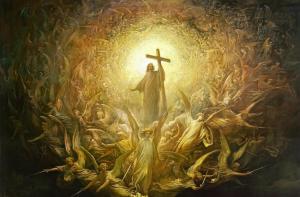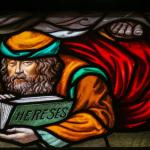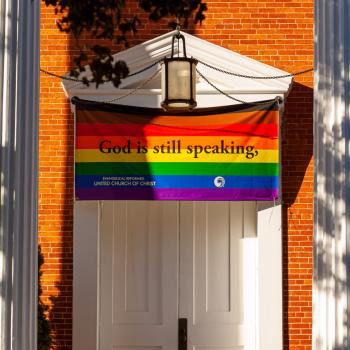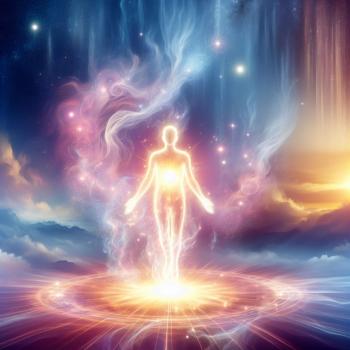G.K. Chesterton once summarized the religious history of the world in a single sentence:
Paganism was the largest thing in the world, and Christianity was larger, and everything since has been comparatively small.
Chesterton, The Catholic Church and Conversion
This Christmas, it is important to recognize one “true meaning of Christmas” that often goes unmentioned, or even unnoticed, by our contemporary makers of meaning. And this regardless of whether they themselves are fans or foes of Christmas. What these meaning-makers miss is that the birth of Jesus also meant the death of something else. That “something else” was Paganism.
If Jesus of Nazareth is anything more than a baby in a manager, then He is this: He is the historical figure who ushered in the demise of the entire pagan world. And, as Chesterton said, it was a large world. Of course, we also believe Christ was able to do this not only because he was a charismatic historical figure, but because He was literally God in literal history. In more theological terms then: it is the Christian message of God’s incarnation in Christ, and his triumphant Resurrection over death that ushers in the era of the Christian Community, or Church, and launches a mission of epic proportions– to spread this Good News of God in Christ to the entire world. That world, again, being predominantly pagan.
It is this single event, the birth of Jesus, that fundamentally shifts the whole of human history. There is no other event in time more significant than this one, regardless of whether you find yourself on the pro-Christ or pro-Pagan side of the equation. The birth of Christ was the death of Paganism, and the advent of the Church was a global takeover. It was, as John tells us in his Gospel, the light coming into a dark world.
4 In Him was life, and the life was the Light of mankind. 5 And the Light shines in the darkness, and the darkness did not grasp it.
9 This was the true Light that, coming into the world, enlightens every person. 10 He was in the world, and the world came into being through Him, and yet the world did not know Him.
But What was Paganism?
We might define Paganism first by what it was not. Paganism was not monotheistic. This is perhaps the most fundamental thing we can say about ancient paganism. In contrast to monotheism, most ancient religions are best described, metaphysically speaking, as animistic, polytheistic, or pantheistic. Some were also dualistic, meaning, there were two equally powerful, eternal forces locked in everlasting combat (think of “The Force” in Star Wars, sort of). However, few, or none, were monotheistic.
We might say it this way: most ancient religions had an immanentist view of God. This means that God was either in everything, or that everything just was God or that everything was god-like. Perhaps the most common version of this was that there was a panoply of gods, a divine assembly that inhabited, or presided over, the objects and processes of the visible world. These gods, of what we now call “Paganism,” were represented by what we now call “myth.” They were not that different from humans really.
In fact, aside from their immortality, they were quite like us; so much so that most modern people, albeit not all modern people, believe that these ancient gods were nothing more than anthropomorphic projections of human minds (something some of the ancient Israelite prophets also thought, see Jeremiah 10). Historian Paul Veyne characterized the pagan gods this way:
The pagan gods, by contrast [to the biblical God], live their lives and are not confined to a metaphysical [transcendent] role. They are part of this world, one of three races that populate the earth: animals, which are neither immortal nor gifted with reason; humans, who are mortal but reasonable; and gods, who are immortal and reasonable. So true is it that the divine race is an animal genus that every god is either male or female.
Veyne, A History of Private Life: From Pagan Rome to Byzantium (208)
Moreover, for the most part, all cultures around the world had this basic understanding of the world: that the world was enchanted with god-like beings or divine, mysterious powers. This was roughly the same for the ancient Greeks, as well as the Algonquins. The philosopher, Charles Taylor, described this ancient, pagan world as “enchanted,” meaning that ancient cultures experienced the natural world as imbued with “spirit agents”– innate, mysterious powers that had their own wills and intentions, moods and attitudes. Max Weber, the father of modern sociology, argued that the world had become “disenchanted” through the rise and dominance of Christianity, as well as the scientific revolution of the Enlightenment (which some argue would not have occurred apart from Christian theology). It is questionable that our modern project of science would have occurred if the world had remained pagan (more on that here).
The Ancient Battle Between Israel and the Pagans
In contrast to this pagan view of nature, there were a handful of ancient communities that believed roughly the opposite of this: that there was only one God. Further, this God was separate from and transcendent to the realm of nature, i.e., from the cosmos. Following logically from this, this God, and only this God, was eternal and uncreated and that the world human beings inhabited was not eternal or uncreated, and, likewise, neither were its gods. The most obvious and relevant example of a community like this were the Israelites. Their greatest prophet, up until Christmas at least, was Moses, who opened the written revelation of this God to mankind with these words:
1 In the beginning God created the heavens and the earth.
2 Now the earth was formless and empty, darkness covered the surface of the watery depths, and the Spirit of God was hovering over the surface of the waters. 3 Then God said, “Let there be light,” and there was light. 4 God saw that the light was good, and God separated the light from the darkness. 5 God called the light “day,” and He called the darkness “night.” Evening came and then morning: the first day.
Genesis 1:1-5
Moses went on to write that all of the natural objects that mankind believed to be themselves divine were, in fact, not divine. They were fascinating things, to be sure, but they were neither alive (in the sense that God is alive, or as men are alive) nor were they worthy of man’s worship (again, see Jeremiah 10). The sun, the moon, the mountains, the seas and the trees were not imbued with sacred forces or energies. Nor were they operated or controlled by naiads or nymphs; dyads or daimons; Zeus, Apollo or Athena (even if these beings existed). Indeed, in not being alive, these things, when compared to man who has life, were actually quite inferior to him! That is the case even if he is physically smaller than most of them. The men represented on Mt. Rushmore were greater than the stone into which their faces were carved (and that regardless of what you think of their politics).
Further, the objects of nature operated in strict accord with the will and the intentions of the one, true and only Creator. In his commentary on Genesis, Nahum Sarna explains this radical belief of the ancient Jews:
Here [in Genesis 1:11] the earth is depicted as the mediating element, implying that God endows it with generative powers that He now activates by His utterance. The significance of this singularity is that the sources of power in what we call nature, which were personified and deified in the ancient world, are now emptied of their sanctity. The productive forces of nature exist only by the will of one sovereign Creator and are not independent spiritual entities.
The history of Israel is the history of a persistent spiritual and physical battle between the following: between Yahweh the Creator and others of His creatures who rebelled against Him; between the belief in one, big God and belief in many, little gods; between the one, revealed religion of the Israelites and the many speculative religions of the pagans; between God’s people and not-God’s people; between the transcendent and the immanent; between miracles and magic; between light, love and liberty and darkness, bondage and the power of death.
This story, itself quite unwelcome to many, has several culminating points: destruction via a global flood because so many had become so wicked through their pagan belief and practice; an exodus from a pagan land filled with magic and evil power and into a land set aside for true religion and free worship; the giving of the Moral Law in order to establish righteous living in the land; and the repeated failure of God’s people to stay true to the Law and not become pagans themselves. Finally, and most important so far, the literal entry of God, the Creator, into His own creation to set things back in order again–not just for Israel, but for the whole world.
That this happened, or began to happen, in one particular geographical area (what we today call “The Middle East”), over an extended period of time, doesn’t mean it couldn’t have happened in some other geographical area, over some other period of time. Especially given the rather universal nature of paganism prior to the advent of Christ, God’s penultimate revelation, this is not unreasonable to believe.
How Christ killed Paganism
Jesus once spoke to his disciples, especially Peter:
13 When Jesus came to the region of Caesarea Philippi, He asked His disciples, “Who do people say that the Son of Man is?”
14 And they said, “Some say John the Baptist; others, Elijah; still others, Jeremiah or one of the prophets.”
15 “But you,” He asked them, “who do you say that I am?”
16 Simon Peter answered, “You are the Messiah, the Son of the living God!”
17 And Jesus responded, “Simon son of Jonah, you are blessed because flesh and blood did not reveal this to you, but My Father in heaven.18 And I also say to you that you are Peter, and on this rock I will build My church, and the gates of Hades will not overpower it.19 I will give you the keys of the kingdom of heaven, and whatever you bind on earth is already bound in heaven, and whatever you loose on earth is already loosed in heaven.
Matt 16:13-19
In this episode of Jesus’ earthly ministry, He takes his disciples through a particularly pagan part of Israel, namely, Caesarea Philippi. This area had been a place dedicated to the worship of the Canaanite god “Baal,” Yahweh’s oldest rival, in times already ancient by Jesus’ day. In Christ’s time, the name of the false god had changed to Pan, but the nature of the place (also called “Panias”) and its practices remained the same: the honoring of an imposter deity as if he was the Deity.
The late Michael Heiser reminds us that Jesus has come, first and foremost, to declare war on the gods of the pagans (and, in doing so, to declare war on sin itself):
The coming of the incarnate Yahweh (Christ) was the beginning of reclaiming [the] nations…But the gods of darkness [the pagan gods] were not going to surrender their domains without a fight–and the battle began so quickly [after Jesus’ baptism] that Jesus barely had time to dry off.
and,
The ministry of Jesus marked the beginning of repossession of the nations and the defeat of their elohim (gods).
Heiser, The Unseen Realm (276, 278)
In addition to the location, Jesus uses the Greek term “Hades” to represent the evil powers that worked against God’s plan for humanity. Hades was both a place and a god in Ancient Greece. Jesus’ point here is crystal clear: He is going to initiate something new, a new dispensation of God’s grace, the next phase of the battle plan that will destroy the “gates” of Paganism’s main headquarters: hell, the realm of the dead. In the ancient world, the “gates” of a city were its outermost defenses. A city without gates was pregnable and, as such, bound for destruction at the hand of an enemy force. Heiser goes on:
The theological messaging [of Matthew 16:13-19] couldn’t be more dramatic. Jesus says he will build his church–and the ‘gates of hell’ will not prevail against it. We often think of this phrase as though God’s people are in a posture of having to bravely fend off Satan and his demons. This simply isn’t correct. Gates are defensive structures, not offensive weapons. The kingdom of God is the aggressor. Jesus begins as ground zero in the cosmic geography of both testaments to announce the great reversal. It is the gates of hell that are under assault–and they will not hold up against the Church. Hell will one day be Satan’s tomb.
Heiser, 284-285
In sum, Jesus’s incarnation and subsequent mission will usher in a new power of God, one contained in His Church, that will take over all pagan strongholds in the world and bury the devil and his followers. In modern parlance: for the pagans and their gods it is “game over!”

Paganism Resurrected?
There is a trend going around the country this year at Christmas: it is a fascination with a little known, gremlin-like creature from Austrian folklore called the “Krampus.” In Austria, Der Krampus is like an evil servant of St. Nicholas. Krampuses are sent out in advance of Christmas Day to punish naughty children so that Der Heilige Nicholas (the Saintly Nicholas), Bishop of Myra, can come and reward the good children with gifts and presents in honor of the coming of Christ, destroyer of the pagans.
In America right now, however, it is the Krampus who is being heralded as “authentic” and cool, while Santa Claus is treated as “inauthentic” and, well, kind of lame. But this is just one of an increasing multitude of evidences for a reemerging paganism in the West. Of course, neopaganism is itself not new, it began to lurch out of the shadows in the mid 19th-century with the rise of occultism in Europe. However, that paganism and witchcraft are now saturating popular American culture is hardly controversial. But how could this be if Christ has already conquered the pagan world, as Chesterton told us 100 years ago? Could it really be the case that Paganism has been resurrected, or, at least, resuscitated?
The answer is yes, it has. And in the next article, I will explain why that is the case, and also why Christians have no reason to fear the looming darkness of a neopagan world.













